
It was a hot, humid, and rainy June night in 1965 at the Kiel Opera House in St. Louis. As the hipsters of the time would’ve said, wigs were about to be blown.
The late Father Dismas Clark’s Dismas House of St. Louis had struck gold for its fundraiser, booking the Rat Pack, the most popular entertainment act in the country, to put on a closed-circuit concert and raise money for its legendary work getting ex-cons back on their feet.
The city of St. Louis rolled out the red carpet for The Frank Sinatra Spectacular, and little wonder: The guys who would entertain that night were at the peak of their careers and their friendship. It was just what you would expect from these friends and onetime neighbors in Palm Springs.
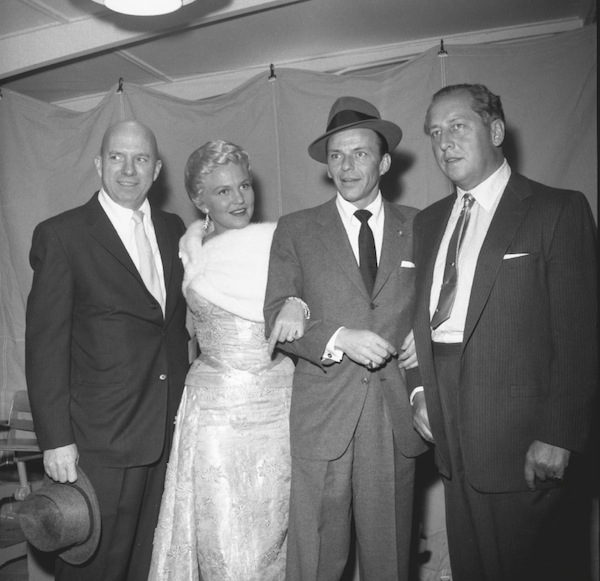
PHOTOGRAPH COURTESY PALM SPRINGS HISTORICAL SOCIETY
The ninth annual Police Show on March 29, 1958, From left, Jimmy Van Heusen, Peggy Lee, Sinatra, and Ray Ryan.
Dean Martin, for example, was coming off a year when his recording for Frank Sinatra’s label Reprise Records, “Everybody Loves Somebody,” had become a Billboard smash.
Sammy Davis was also experiencing a career flash. Davis was a headliner in Vegas at Frontier Casino and gifted in nearly every aspect of show business, from playing the drums and performing spot-on impressions to amazing eat-your-heart-out-James-Brown footwork.
At the center was Frank Sinatra. He was turning 50 that year and king of the hill. His Reprise label was keeping up with the big boys. On top of Martin’s single and subsequent LP due out in a few months, Reprise would also release Sinatra’s classic September of My Years and subsequently, in 1966, “Strangers in the Night,” “My Way,” “That’s Life,” and “Summer Wind.” The April 23 issue of Life magazine featured his life and career in mostly flattering words and large pictures.

PHOTOGRAPH COURTESY PALM SPRINGS LIFE ARCHIVES
Dean Martin, Judy Garland and Frank Sinatra on The Judy Garland Show, 1962.
There was usually a fourth member of the Pack in the act, Joey Bishop, but he had thrown out his back the day before the trip, so his spot was taken by then Tonight Show host Johnny Carson, who gamely tried to keep up with the other three.
The performance showcased the great camaraderie among these stars. It was essentially a redo of their nightclub act from the Sands Hotel in Las Vegas and it must have been quite an experience for the St. Louis audience, seeing these grown men having so much fun with one another.
The takeaway from the show: friendship, a perfect blendship.

PHOTOGRAPH COURTESY PALM SPRINGS HISTORICAL SOCIETY
Frank Sinatra and Eva Gabor at his June 9, 1971 inauguration as honorary mayor of Cathedral City.
“They did genuinely like each other,” Barbara, Frank’s fourth and final wife, wrote in her memoir, Lady Blue Eyes: My Life with Frank.
Even today, watching Frank, Dean, and Sammy together serves as a model for what male bonding is supposed to look like: guys teasing each other good-naturedly about their looks and backgrounds, busting each other’s chops.
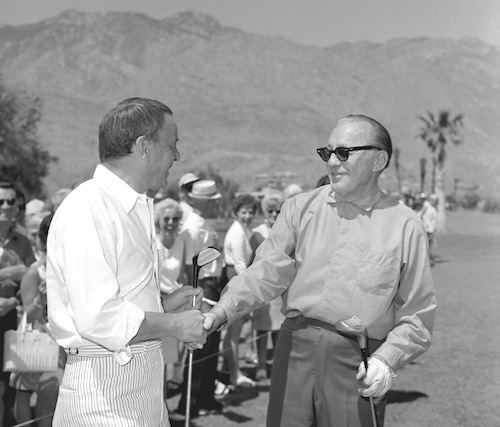
PHOTOGRAPH COURTESY PALM SPRINGS HISTORICAL SOCIETY
Frank and Jack Benny agree to let the best man win at the Chuck Connors golf tournament, Canyon Country Club, April 20, 1969.
One problem with that, though: These guys couldn’t be onstage all the time. When lives are lived in the glare of the public eye, friendships can suffer the same ups and downs as those of just regular Joes who don’t have a Pack.
While Frank Sinatra could claim to have hundreds of “friends” — one would get an invitation to dinner and discover that one was part of a huge group, with Sinatra being a distant figure at the end of a table or across the room — there were levels to the meaning. And one steadfast rule: With only a few exceptions, when you were “in” you were in but when you were on the outs, it was very often forever.
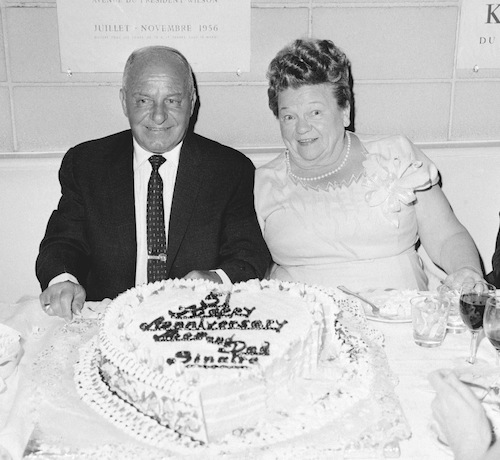
PHOTOGRAPH COURTESY PALM SPRINGS LIFE ARCHIVES
Mom and Dad Sinatra celebrating their anniversary.
AMICI
One biographer of Sinatra, perhaps working on a deadline and desperate, once tried to link Frank’s zodiac birth planet, Jupiter, to Sinatra’s many friends: Just as the giant planet was always accompanied by many moons, so was the hail-fellow-well-met, let’s-party Sinatra with his hundreds of hangers-on.
Luckily, Sinatra had a lifelong best friend in his mother: Natalie Catherine Garavente Sinatra, “Dolly.”
“She was a pisser,” Sinatra told Bill Zehme in The Way You Wear Your Hat, bestowing his highest praise in hipster hyperbole. They were inseparable all the way until her death in a plane crash in 1977 on what the family calls “Grandma’s mountain,” within view of the Compound, the Sinatra home in Rancho Mirage.
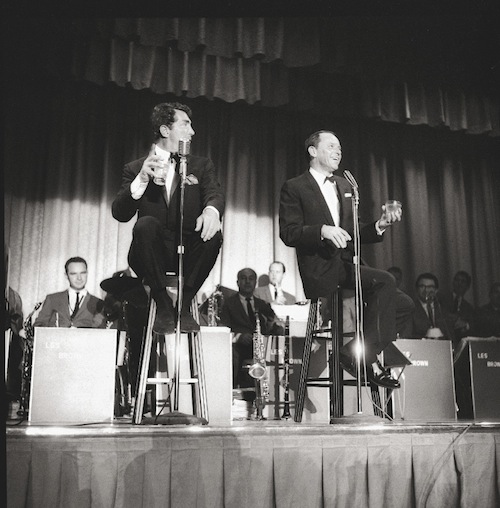
PHOTOGRAPH COURTESY PALM SPRINGS LIFE ARCHIVES
Frank Sinatra and Dean Martin performing at the Riviera, Palm Springs.
Only a few other women got as close to him as Dolly, but one was Rosalind Russell, just about as unlikely a friend of Frank’s as one could imagine. “Roz,” the Waspy upper-classy thé-a-ter star, and her producer husband Frederick Brisson were two of the most frequent guests at the Compound during the early 1970s, around the time of Sinatra’s “retirement.” Frank would fly them in by Lear Jet. Was it a wild time there? Oh please. “Let me tell you about Frank,” Roz once told a friend. “Wherever he is, he’s on the phone two or three times a day with his children. And the grandchildren? He overbuys presents for them.”
Roz was extra special to Frank. In 1973, when she was to be awarded the Jean Hersholt Humanitarian Award at the Oscars, Sinatra called producer Howard Koch and insisted on being her presenter. His tribute to her included lauding her work with the Jewish aged in Los Angeles’ Boyle Heights as well as other Clara Barton–type endeavors.

PHOTOGRAPH COURTESY PALM SPRINGS HISTORICAL SOCIETY
Frank Sinatra, Dean Martin, and Sammy Davis Jr. performing at Canyon Hotel for the Valentine Love-in for Desert Hospital. 1983.
Other female friends, however, came and went. Lauren Bacall, once an original member of the Rat Pack when her husband Humphrey Bogart was alive, thought of herself as Frank’s buddy, but when she leaked to the press that he had asked her to marry him, the relationship ended. Angie Dickinson was a good friend in the '60s when the Pack was in full swing.
But Frank was mostly a man’s man. He liked male company, watching Monday Night Football with his buddies, the happy, no-pressure rounds of golf where no one took it seriously, drinking until dawn (he had awful insomnia), and entertaining his men friends with the finest “talent” his buddy Jimmy Van Heusen could scare up.
One man’s company he relished was that of comedian Jack Benny. “When Jack died [in 1976],” Barbara later wrote in her memoir, “it really hit him hard.” And the young Robert Wagner also became close to Sinatra — he broke down while giving the eulogy at Sinatra’s funeral and recalled in an interview getting “great career advice” from Frank throughout the years.
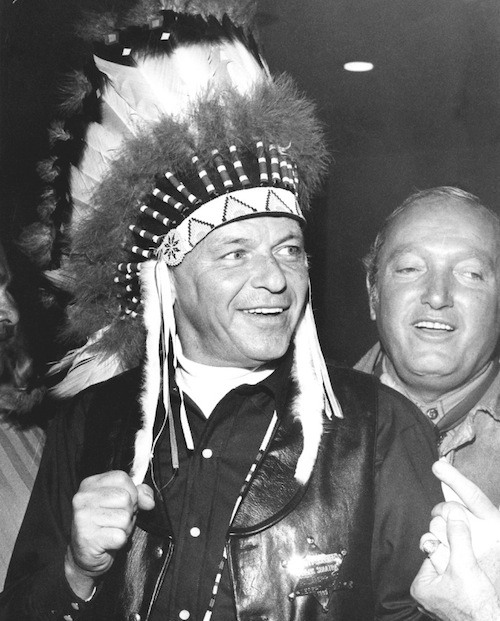
PHOTOGRAPH COURTESY PALM SPRINGS HISTORICAL SOCIETY
Frank Sinatra and Jilly Rizzo, Desert Circus, 1963.
COMPAGNOS
But those were the outliers. The really truly deeply friends were mostly Italian.
Paul “Skinny” D’Amato, for example, was sort of Sinatra’s big brother in the early part of his career, often referred to by Frank Jr. as “Uncle Paul.” Owner of Atlantic City’s 500 Club, a nightclub that hid its gambling essence when that particular aspect of the club business was illegal, Skinny drew high rollers to his established permanent crap game by featuring talent like Sinatra and Martin and Lewis. When he died in 1984, Frank was one of the pallbearers, the only time he ever honored anyone in that manner.
Tony Consiglio was another of Sinatra’s dearest pals. He was called “the Clam” because he kept his trap shut during Frank’s lifetime, and his tonsils were exposed only after Frank died, with the publication of Sinatra and Me: The Very Good Years.
As Frank’s friend since they were teenagers, Consiglio knew every Sinatra mood. Dolly used to tell him, “I put Frankie on this earth but you know him much better than I do.” One time when Frank’s mood turned sour and abusive, Tony decided to pack up and leave the Palm Springs house. As he recalls in his book, Sinatra couldn’t believe his friend was walking out.
“Tony, you’re not really mad, are you?’” asked Sinatra in disbelief.
‘Well, Frank, I feel bad especially because I haven’t done a thing and I got screamed at.’
“Frank sat on the bed next to my suitcase and said, ‘To be truthful with you, Tony, if I can’t blow my steam off with my best friend, who am I going to do it with?’”
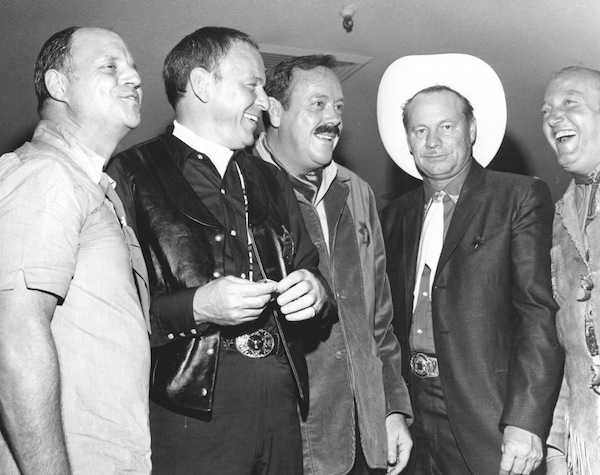
PHOTOGRAPH COURTESY PALM SPRINGS HISTORICAL SOCIETY
Don Rickles, Frank Sinatra, Chief Bob White, Warren Coble (Palm Springs contractor and president of Desert Circus Week in 1970), and Jilly Rizzo, Desert Circus Banquet Ball annual fundraiser, 1970.
In descending order of paisans there were altri amici: golfer Ken Venturi, Calloway Golf co-founder Tony Manzoni (Frank was the godfather of Tony’s daughter Tiffany), New York Yankee Joe DiMaggio, former boxer Hank Sanicola, crooner Tony Bennett (who founded a performing-arts high school in New York named after Sinatra), and baseball managers Leo Durocher and Tommy Lasorda. There is also the inexplicable friendship between Mr. S and Don Rickles, curious even to Sinatra. “I like him because I have very poor taste,” he once said.
Not all of those friendships lasted forever but two lasted all the way to death: fellow songsmith Dean Martin and saloon owner and compagno costante Jilly Ermenigildo “Jilly” Rizzo.
Dean Martin was Number One, although he and Frank didn’t spend a lot of time together. They kept different hours. Dean refused to stay up late; Frank would not go to bed. But they were close. Blood brothers. In Nancy Sinatra’s My Father, Dean revealed that “we cut the top of our thumbs and we became brothers. To me, he’s always been my brother. We’re alike.”
“Frank was especially fond of Dean,” Barbara says, and Frank once said Martin was “like the air I breathe, always there, always close by.” They had their rituals, especially when it came to looking sharp.
Proof that Sinatra really cared about Martin came in 1988 when he arranged for him, Sammy, and Dean to tour in a series of concerts they called Together Again. A year earlier, Dean had been devastated by the tragic death of his son, Dino, whose plane plowed into the same mountain that took Sinatra’s mother years earlier. Dean was inconsolable and Frank thought that getting back into the swing of things, getting the old gang back together might take his mind off the horrible tragedy.
Dean’s troubles, however. would not pack neatly into Frank’s kit bag, and eventually the grieving Martin dropped out of the show and the two became estranged — Frank calling Dean’s quitting “unprofessional.” In fact, it wasn’t until Dean was at death’s door that he and Frank reconciled. After Dean died, Frank took it hard. “The one who brought more fun into Frank’s life than anyone else,” Barbara noted in her memoir “… was gone.”
You like people and they die on you,” Sinatra said more than once, but a guy he really liked, Jilly Rizzo, didn’t seem like the kind of guy who would ever die on anyone. Rough-and-tumble, his one good eye on the lookout for anything that might be trouble, Rizzo ran one of the most successful saloons in New York City, not a profession for the shy and timid. Sinatra liked the place; it wasn’t fancy and he liked the Chinese food. When Sinatra’s pallies like Pat Henry started moving west, so did Jilly, and in 1965, he opened Jilly’s Restaurant & Bar on South Indian Canyon Drive to be closer to Frank. It quickly became Frank’s place.
“Of all my dad’s countless friends,” younger daughter Tina wrote in My Father’s Daughter, “none was more devoted to Dad than Jilly.”
Jilly and he were cut from the same cloth, Tina wrote. “They’d relax by the pool during the day, reading the papers and talking sports and politics. They especially looked forward to Monday Night Football, where Jilly would pace their bets with a bookmaker friend.”
It was Jilly who often ran interference for Frank when he was out in public. Jilly let him enjoy being out without the hassles, keeping all at bay. Jilly was always there when Frank needed him.
Then one night he wasn’t. On his 75th birthday, Jilly was killed by a drunk driver outside Mission Hills Country Club in Rancho Mirage. His white Jaguar was crushed by a Mercedes and caught fire as the drunk driver of the other vehicle fled the scene on foot. It was devastating to Sinatra.
Some said that after Jilly died Frank stopped his favorite hobby, painting. It was devastating, no doubt, but Frank was not down too long. (He wasn’t a self-diagnosed manic-depressive for nothing.) “He did stop for a while but eventually he went back to it. It was too important to give up forever,” Barbara says.
PER SEMPRE
Friendships could certainly be a less than a perfect blendship with Sinatra. And when it was over, it was over. Forever.
Mia Farrow discovered it when Sinatra’s attorney showed up on the set of Rosemary’s Baby to hand her divorce papers.
His trusty valet, George Jacobs, discovered it when one day Sinatra just tossed him out of the house without a word because Mia had once asked George to dance.
It happened to Peter Lawford after he told Sinatra that JFK wasn’t going to stay at the Compound but instead had decided to spend his desert days at Bing Crosby’s. That messenger was figuratively rubbed out.
Supposed best friend Brad Dexter, who once saved Sinatra’s life, discovered it when suddenly he was no longer part of the team.
It happened to press agent Jim Mahoney as well. Sinatra was getting bad press in Australia and Jim was off in Scotland taking care of another client. Soon, Sinatra was off his client list.
And, eventually, attorney Mickey Rudin, who handed out all the pink slips, also ended up being shown the door.
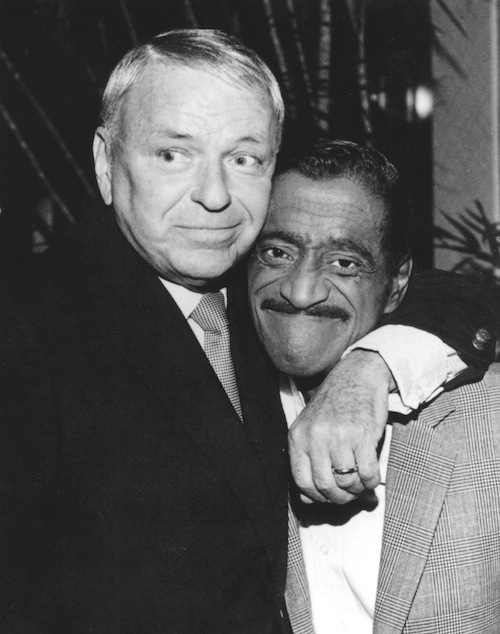
PHOTOGRAPH COURTESY PALM SPRINGS LIFE ARCHIVES
Frank and Sammy.
One guy managed to survive all the bust-ups. Sammy Davis Jr. was unique among Sinatra’s friends.
“A friend in need is a pest,” one of Sinatra’s favorite comics, Joe E. Lewis, used to say, but Sinatra was usually very helpful to those buddies in need.
Unfortunately, Sammy (or “Smokey” as Sinatra called him) was just about always in need. He was profligate and never bothered to save. He made a nice comfortable living but spent money way beyond his means and frequently hit up Frank for dough.
One request really got to Frank: Sammy’s wife Altovise was expecting, and Sammy told Frank about the nursery he wanted to build for the new addition. Sinatra could relate: There wasn’t anything he wouldn’t do for his kids. So he gave Smokey the money for the nursery.
Some time later, while Frank was in Burma (now Myanmar) filming Never So Few, he heard from a friend about the great evening the friend had spent at Sammy’s house. “He just built the most fantastic screening room, Frank,” the friend said. “Puts yours to shame.”
Realizing that Sammy had used the generously bestowed “nursery money” for a luxe screening room, he exploded.
“Sammy,” he said to his longtime friend, who was scheduled to appear in the film as Sinatra’s driver, “you’re out!” And he was. He was replaced by a new actor on the scene named Steve McQueen. The actor impressed the film’s director, John Sturges, so much that Sturges cast him in another movie. It made McQueen a major star: The Magnificent Seven.
But Sammy and Frank didn’t stay on the outs forever. When Sammy got into financial trouble again, Sinatra arranged for himself, Dean, and Sammy to tour to get him back on his feet.
Frank Sinatra’s attitude toward show business friends was summed up by close friend Eddie Cantor, who once called Sinatra “one of the most generous guys” he’d ever known.
When From Here to Eternity brought Sinatra back from the lowest point of his career, Cantor remembered, “one of the studio executives who had given him the brush before the film gushed over him one night at a Palm Springs party. ‘Frankie,’ he asked, ‘when your career was in a slump did you learn anything that helps you now?’ Frank answered bluntly: ‘Yes, the shortest distance between two points is a pat on the back and a kick in the pants.’”